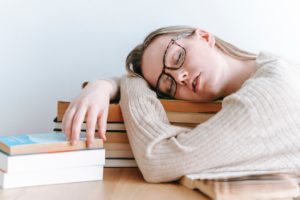 Do you run out of steam halfway through the day? You’re not alone. The Sleep Foundation reports at least 50% of adults experiences daytime fatigue 3 to 7 times per week. If you’re feeling exhausted during the day, a quick power nap can recharge your batteries. However, if you have sleep apnea, you’ll want to reconsider dozing off after lunch. Napping and sleep apnea can be a bad mix. Here’s how you can get the rest you need to feel your best.
Do you run out of steam halfway through the day? You’re not alone. The Sleep Foundation reports at least 50% of adults experiences daytime fatigue 3 to 7 times per week. If you’re feeling exhausted during the day, a quick power nap can recharge your batteries. However, if you have sleep apnea, you’ll want to reconsider dozing off after lunch. Napping and sleep apnea can be a bad mix. Here’s how you can get the rest you need to feel your best.
Sleep Apnea and Your Sleep Quality
Sleep apnea is a condition that causes several pauses in breathing frequently throughout the night. The most common cause is an obstruction in the back of the mouth or throat that restricts the airway. You can stop breathing hundreds of times per night, with each interruption lasting for up to one minute or longer.
As your body is depleted of oxygen, your brain will signal you to wake up to restore normal breathing. You may not be aware of the repeated awakenings, but they will interrupt your sleep cycle. As a result, you can deal with ongoing daytime fatigue, but that’s not the only concern. Eventually, sleep deprivation can occur, which can affect your mood, memory, and even your driving. According to the Center for Sleep Medicine at Northern Westchester Hospital, drowsy driving is responsible for nearly 100,000 auto accidents annually.
Unfortunately, a brief nap won’t lower your risk. Snoozing in the afternoon isn’t enough to repay your sleep debt. Instead, it can worsen because it may be more difficult to fall asleep. The tossing and turning can create an ongoing cycle of napping and daytime fatigue.
Get a Good Night’s Rest
You should only nap when necessary to avoid throwing off your sleep schedule. If you have sleep apnea, it’s best to visit your dentist for treatment. If you have tried a CPAP in the past, you don’t need to worry about hoses or noise affecting your ability to fall asleep.
An oral appliance is a comfortable and convenient solution to breathe easier to sleep better. It repositions the lower jaw forward to keep the airway open to prevent an obstruction. It’s an effective method to treat mild-to-moderate cases of sleep apnea that provides quick results. After just one night, you may see an improvement in your sleep quality, especially when combined with:
- A set sleeping schedule to ensure you get 7-9 hours of rest.
- A sleep environment that’s about 65-degree Fahrenheit and free of lights.
- A reduction in screen time before bed.
Sleep Soundly Tonight
You don’t need to rely on napping or coffee to make it through the day. Invest in the benefits of an oral appliance today.
About Dr. Glenn Thompson
Dr. Thompson earned his dental degree from the Tufts University School of Dental Medicine before continuing his training in oral appliances for sleep apnea. If you’re ready to stop snoring or need sleep apnea therapy, contact our office today to see if you’re a candidate for an oral appliance.